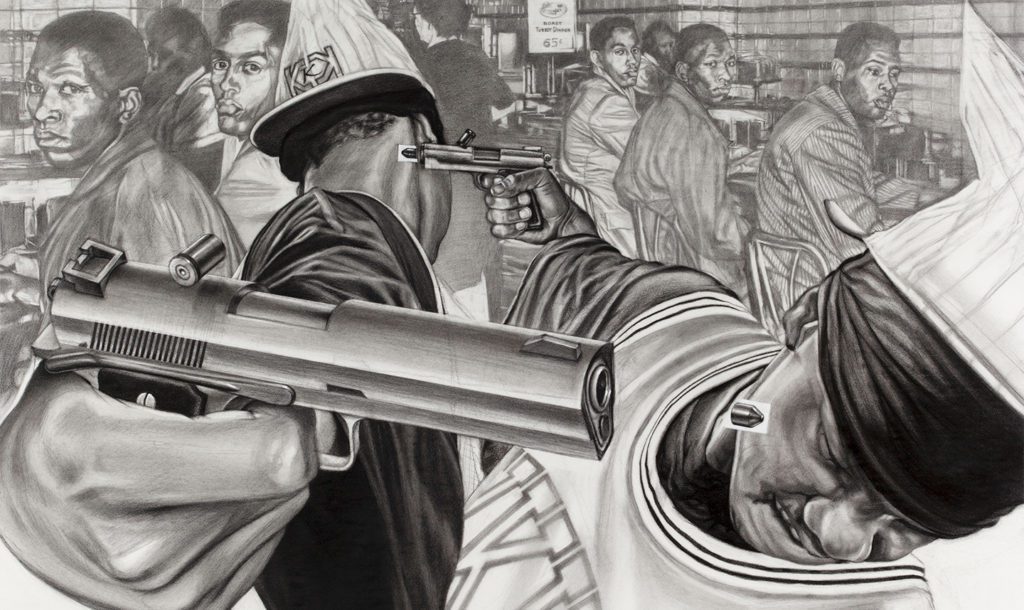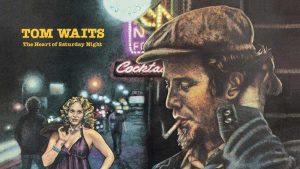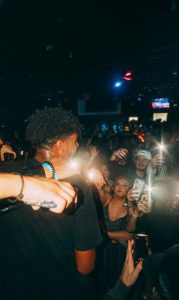In March 2019, the National Civil Rights Museum opened a controversial exhibition entitled Kin Killin’ Kin. Artist James Pate has created images comparing Black-on-Black violence to the history of terrorism by the Ku Klux Klan. The graphics show African American youth murdering each other wearing Klan regalia. Visual references to episodes in the Civil Rights Movement and the Hip Hop culture are included in the series. With statistics of young black men as victims of homicide on the rise, Hip Hop music has become one of the leading forms of storytelling. Since the 1980s, Hip Hop artists have conveyed stories of urban violence from several different perspectives.
African American Hip Hop artist, 2pac, was familiar with the violent
narratives. Prior to his highly publicized tension with the Notorious
BIG, 2pac issued his take on Black violence in his debut single “Souljah’s Story.”
2pac emphasized that cutting welfare would lead to more social ills
because poor blacks who depended on this assistance would increasingly
turn to crime without it.
In 1996, Queens, NY rapper Nas released the unforgettable “I Gave You Power,”
where he spoke from the animated perspective of a gun. Nas’ frustration
as a weapon can be felt in the lyrics, “He squeezed harder, I did not
budge, sick of the blood, sick of the thugs, sick of wrath of the next
man’s grudge”[1] In
the voice of the gun, Nas demonstrates the weapon’s (his) resistance to
violence by withholding gunfire. Nas portrays the gun’s paradoxical
existence, “My creation was for blacks to kill blacks.” Nas takes a
stand by not allowing the gun (himself) to be used for that purpose.
Hip Hop music also took a political stand as heard in Public Enemy’s 1989 song, “Fight the Power.”
Member Chuck D asserts, “Freedom of speech is freedom of death,”
comparing his position to that of Frederick Douglass’, “If there is no
struggle, there is no progress.”[2] Both
were advocating that nothing will be given to you, and that you must
persevere to succeed. A generation after the Civil Rights Movement of
the 1960s and 70s, African Americans were not experiencing universal
equality. Blacks were being systematically oppressed in more subtle
ways. Public Enemy’s goal in “Fight the Power” was to convey the
continued heated tension in contemporary America, and help people see
racial intolerance, violence, and police brutality from the perspective
of those who were marginalized or oppressed. African Americans were
impoverished and forced to live in low-economic areas where violence
frequently occurred.
Famed female artist and actress Queen Latifah also brought to the
forefront violence and assault against women in her provocative “U.N.I.T.Y.”
Latifah illustrated women and communities suffering as a result of the
frustrated males who turned to violence because of their social
condition and inequalities endured daily.
There have also been a few uplifting and inspirational tributes to
end black violence. KRS-One formed a Hip Hop-themed, “We Are the
World”-like song entitled “Self Destruction.”
This track featured the Hip Hop elite including MC Lyte, Public Enemy,
Doug E. Fresh and Heavy D. It urged communities across the nation to
unite with one another, instead of increasing the murder rate of black
men at the hands of black men. Kool G. Rap also formed alliances with
major artists in the motivating “Erase Racism,”
where he dreamed of a day when everyone is colorblind. Kool G. Rap also
advocated for education and solidarity “The ink is black, the page is
white, together we can learn to read and write.” [3]
At the end of his career, 2pac’s posthumous song “Changes”
provided a sense of hope for those who were affected daily by youth
violence. 2pac pointed the finger at his African American community for
the hate and anger it held. He rapped “I got love for my brother, but we
can never go nowhere unless we share with each other. We gotta start
making changes; learn to see me as a brother instead of two distant
strangers.”[4]
2Pac believed his people were to blame for the violence because of
selfishness, jealousy and envy toward each other. He urged African
Americans to take a stand.
The Hip Hop culture has long been associated with violence and stereotypes. Hip Hop music and the exhibit Kin Killin’ Kin
at the National Civil Rights Museum both provide narratives of everyday
life that millions of people, unfortunately, are forced to endure.
Viewing the artwork and hearing the lyrics, one can agree that racism
and violence are linked and must be addressed. To understand the roots
of racial violence and move toward reconciliation is perhaps the
greatest challenge.
The post Self-Destruction: A Case Study of Violence and Hip Hop appeared first on Raptology: Rap News – Rap Music – Rap Contests – Rap Articles.




